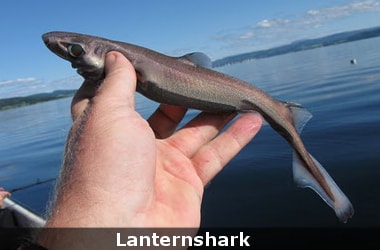
A new species of shark has been discovered by a team of scientists in the depths of the Pacific Ocean.
Etmopterus lailae, a member of the Lanternshark family, is a miniature shark weighing less than 2 pounds and under a foot in length that glows in the dark.
The species was first encountered 17 years ago at a depth of 1,000 feet, but like many discoveries the process of identifying a new species takes many years within the scientific community.
When the shark was first encountered scientists did not realize they had discovered a new species.
It was only after submitting their findings to a journal that the reviewers suggested it was a new species of shark. As there are only 450 species of sharks it is rare to discover a new one.
Some of the features that set Etmopterus lailae apart from other lanternsharks are its odd-shaped head, arched snout, and bioluminescent abilities.
Scientists believe the larger snout is helpful in locating food in an environment with very little light.
While it is difficult to study a species that lives in the ocean depths scientists have come up with several hypotheses for the bioluminescent underbelly of this shark and they cary from mating recognition to camouflage and luring prey.
This miniature, “glow-in-the-dark” shark is a member of the Lanternshark family (Squaliformes: Etmopteridae), which was serendipitously found 1,000 feet below the Pacific Ocean off the coast of the Northwestern Hawaiian Islands.
There are only about 450 known species of sharks worldwide and you don't come across a new species all that often.
A large part of biodiversity is still unknown, so for us to stumble upon a tiny, new species of shark in a gigantic ocean is really thrilling.
This species is very understudied because of its size and the fact that it lives in very deep water. They are not easily visible or accessible like so many other sharks.
Identifying the Etmopterus lailae required an extensive list of measurements, diligent categorization and thorough comparisons with other museum specimens.
Some of the other distinctive characteristics of this new species are its flank markings that go forward and backward on their bellies.
Also there is a naked patch without scales on the underside of its snout, as well as internal differences such as the number of vertebrae they have as well as fewer teeth than the other sharks.
Like other Lanternsharks, the Etmopterus lailae is bioluminescent and the flanks on the bottom of its belly glow in the dark. These markings on its belly and tail also were specific to this new species.
There are a number of hypotheses for why Lanternsharks glow in the dark including mate recognition to ensure they are mating with the right species.
This serving as a form of camouflage to protect them from predators in the deep sea and using bioluminescence to act as a lure to attract little fish or shrimp.
Why Do Sharks Glow?: Know More- There are about 550 species of shark in the oceans. Around twelve percent of them glow.
- These luminous fish belong to two groups: the kitefin sharks and the lanternsharks.
- They are little creatures, no bigger than 50 centimeters long, and they feed on small fish, squid, and crustaceans.
- They also live in the deep ocean One genus alone - the Etmopterus lanternsharks - includes 38 distinct species approximately
- The light comes from many small organs called photophores, which dot their bellies and sometimes their flanks. No one knows how these structures produce light Scientists have found that the sharks use their light for camouflage.
- The glow from their bellies perfectly matches this downwelling light, and cancels out their outlines.
- In technical terms, the sharks use counter-illumination. In simple terms, they cast no shadows.